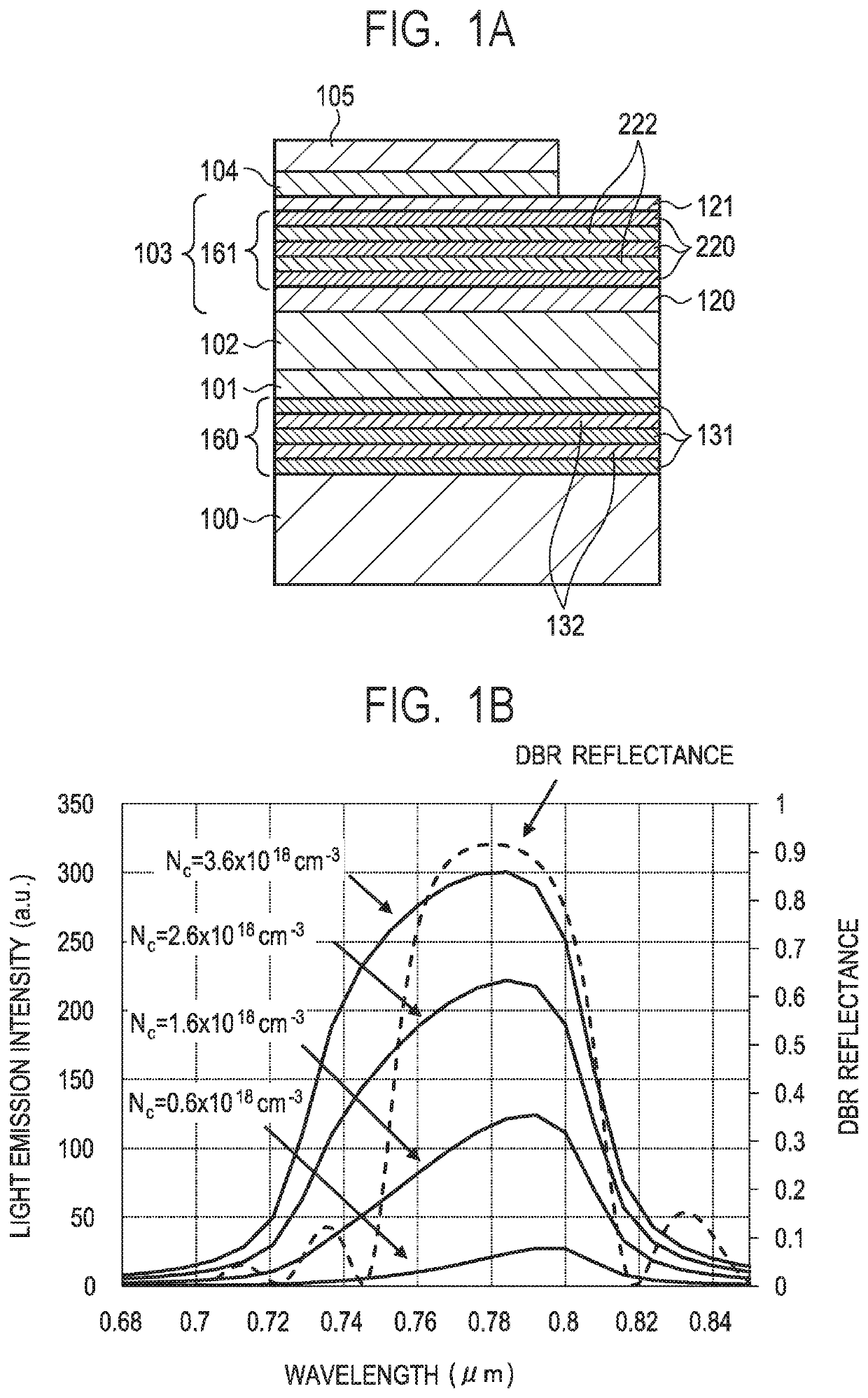Light-emitting thyristor, light-emitting thyristor array, exposure head, and image forming apparatus
- Summary
- Abstract
- Description
- Claims
- Application Information
AI Technical Summary
Benefits of technology
Problems solved by technology
Method used
Image
Examples
first example
[0055]FIG. 2 is an element sectional view of a light-emitting thyristor of a first example. In the light-emitting thyristor of the present example, an n-type GaAs buffer layer 1001, a semiconductor DBR layer 1160, a cathode layer 1002, a p-base layer 1003, an n-gate layer 1004, and an anode layer 1006 are stacked in this order on an n-type GaAs substrate 1000. A current constriction portion 1007 in which an electrical opening (a region in which a conductivity is higher than the outer circumference portion of the opening) is partially provided is formed on the anode layer 1006. A transparent conductive layer 1008 that is transparent to a light emission wavelength is formed on the current constriction portion 1007. An anode electrode 1010 is formed on the transparent conductive layer 1008. The anode electrode 1010 is a ring electrode (flame-shape electrode) and is structured to extract a light emitted by the n-gate layer 1004 and the p-base layer 1003. Further, a gate electrode 1011 i...
second example
[0060]FIG. 3 is an element sectional view of a light-emitting thyristor of a second example. In the light-emitting thyristor of the present example, an n-type GaAs buffer layer 2001, a semiconductor DBR layer 2160, a cathode layer 2002, a p-base layer 2003, an n-gate layer 2004, and an anode layer 2006 are stacked in this order on an n-type GaAs substrate 2000. A current constriction portion 2007 in which an electrical opening (a region in which a conductivity is higher than the outer circumference portion of the opening) is partially provided is formed on the anode layer 2006. A transparent conductive layer 2008 that is transparent to a light emission wavelength is formed on the current constriction portion 2007. An anode electrode 2010 is formed on the transparent conductive layer 2008. The anode electrode 2010 is a ring electrode (flame-shape electrode) and is structured to extract a light emitted by the n-gate layer 2004 and the p-base layer 2003. Further, a gate electrode 2011 ...
third example
[0077]FIG. 4 is an element sectional view of a light-emitting thyristor of a third example. Note that, since the configuration of the present example is similar to the configuration of the second example, the same members as those of the second example are labeled with the same references, and the description thereof will be omitted or simplified in the present example.
[0078]In the light-emitting thyristor of the present example, the n-type GaAs buffer layer 2001, the semiconductor DBR layer 2160, the cathode layer 2002, the p-base layer 2003, the n-gate layer 2004, and the anode layer 2006 are stacked in this order on the n-type GaAs substrate 2000. Further, the anode electrode 2010 is formed on the anode layer 2006 via the current constriction portion 2007 and the transparent conductive layer 2008. The anode electrode 2010 is a ring electrode (flame-shape electrode) and is structured to extract a light emitted by the n-gate layer 2004 and the p-base layer 2003. Further, the gate e...
PUM
 Login to View More
Login to View More Abstract
Description
Claims
Application Information
 Login to View More
Login to View More - R&D
- Intellectual Property
- Life Sciences
- Materials
- Tech Scout
- Unparalleled Data Quality
- Higher Quality Content
- 60% Fewer Hallucinations
Browse by: Latest US Patents, China's latest patents, Technical Efficacy Thesaurus, Application Domain, Technology Topic, Popular Technical Reports.
© 2025 PatSnap. All rights reserved.Legal|Privacy policy|Modern Slavery Act Transparency Statement|Sitemap|About US| Contact US: help@patsnap.com



